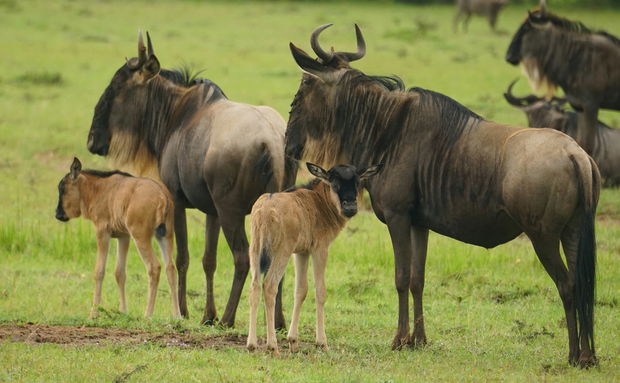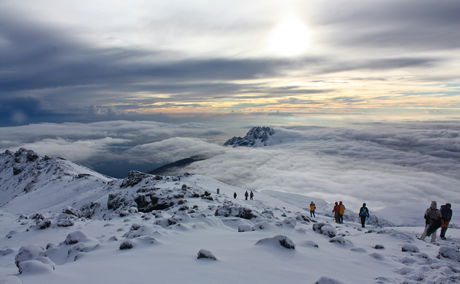Travel Deeper: How Cultural Respect Creates Truly Sustainable Tourism 1) True sustainability goes beyond eco‑habits—it begins with a respectful mindset toward local cultures. 2) Cultural respect strengthens the three pillars of tourism: environmental protection, economic resilience, and socio‑cultural preservation. 3) Empowering communities as guardians, artisans, and storytellers ensures conservation and dignified livelihoods. 4) Travel becomes legacy‑building when it shifts from extraction to authentic human connection.
The Wildebeest Calving Season: A Spectacle of Birth and Survival

This blog explores the breathtaking drama of the wildebeest calving season in Tanzania’s southern Serengeti, where over 500,000 calves are born within a few short weeks between January and March. It highlights the synchronized birthing strategy known as predator satiation, which helps ensure survival by overwhelming predators, such as lions, cheetahs, and hyenas, with sheer numbers. The piece captures the emotional intensity of this natural phenomenon—where life and death unfold in real time—and positions it as a must-see experience for safari travelers seeking raw, unforgettable encounters with nature’s rhythms.
Imagine a vast, golden-green plain stretching to the horizon. The air is thick with anticipation, filled with the low grunts of half a million wildebeest. Then, it begins. Not as one event, but as an explosion of life. A newborn calf struggles to its feet within minutes, wobbling on spindly legs. Then another, and another, until it feels like the very earth is giving birth. This is the wildebeest calving season, the raw, dramatic, and emotionally charged heart of the Great Wildebeest Migration.
For adventure seekers and wildlife photographers, this is the ultimate Serengeti safari. It offers a front-row seat to nature’s most profound theatre, where the circle of life unfolds in scenes of tender nurturing and brutal survival. At Kijani Tours, we believe in experiencing this wonder through eco-friendly travel. We want to ensure this timeless spectacle endures for generations.
Why the Calving Season is the Pivotal Event of the Wildebeest Migration
The Great Wildebeest Migration is a continuous, year-long journey, but the calving season is its biological engine. It’s not just an add-on to your Tanzania safari; it’s the critical phase that replenishes the entire population.
Between January and mid-March, the short-grass plains of the southern Serengeti and the Ngorongoro Conservation Area become a massive nursery. An estimated 400,000 to 500,000 wildebeest calves are born in a incredibly synchronized window, with up to 8,000 newborns arriving each day at the peak. This isn't a random occurrence; it is a sophisticated survival strategy honed by evolution.
The Science of Synchronized Births: A Strategy Called "Predator Satiation"
Why do they all give birth at once?
Because survival in the Serengeti is not a solo act—it’s a symphony of timing, instinct, and ancestral wisdom. Each year, as the rains awaken the southern plains, tens of thousands of wildebeest calves enter the world within a narrow window of just two to three weeks. This isn’t coincidence—it’s a strategy known as predator satiation. By synchronizing births, the herds flood the ecosystem with life, overwhelming even the most skilled hunters.
Lions, cheetahs, hyenas, and jackals may feast, but they cannot keep pace. The abundance is simply too great. In this grand ecological performance, the odds shift: not by fighting, but by multiplying. The predators are full before the feast is done.
If births were scattered across months, each calf would stand alone against the teeth of the wild. But in this concentrated surge, most survive—not because they are faster or stronger, but because they are many. This ancient rhythm is the heartbeat of the Great Migration. A strategy so elegant, it ensures the continuity of life through sheer abundance. It is nature’s way of saying: “We endure, together.”
A Photographer's Paradise: Capturing the Drama on Your Serengeti Safari
For photographers, this season offers unparalleled opportunities. It’s not just about the scale; it’s about the intimate, powerful moments.
1) The First Moments: Capture the profound struggle of a newborn taking its first steps, often with a patient mother nuzzling it along.
2) The Predator-Prey Dynamic: This is the best time to see migration action, with high-intensity predator prey scenes. The abundance of easy targets draws in big cats and hyenas, providing dramatic wildlife action.
3) The Landscape: The "short-grass" plains are ideal for photography. There are no obstructive bushes, allowing for clear, sweeping shots of the vast herds and the dramatic skies of the rainy season.
4) Expert Guidance Matters: A Kijani Tours guide is more than a driver; they are a wildlife expert and a photography spotter. They understand animal behavior, anticipate action, and position your vehicle for the perfect light and angle, ensuring you come home with award-winning shots.
The Circle of Life in Action: Predators and Prey
The calving season supercharges the Serengeti's ecosystem. The concentration of vulnerable prey attracts a stunning array of predators, making every game drive an edge-of-your-seat experience.
1) Spotted Hyenas: The most numerous predators during this time, working in clans to test the herds for any sign of weakness.
2) Lions: This is the raw, beating heart of the African wilderness. As the sea of wildebeest and zebra moves across the plains during the Great Migration, the lion pride follows. They are a powerful, shadowy force trailing the flow of life itself. This chase is not random; it is a strategic pursuit.
With the herds comes opportunity, and the lions' success rate rises. However, calling them "easy targets" overlooks the real drama. Watching a coordinated hunt reveals the apex predator in its element: the silent stalk, the explosive charge, and the sheer power of the takedown. It is a primal, awe-inspiring display of nature's balance, where the abundance of prey supports the reign of the savanna's undisputed king.
3) Cheetahs: But this isn't just about a solitary hunt. This is where an important experience starts. Watch closely, and you might see one of the savanna's most meaningful lessons: a cheetah mother, using this season's slower, newborn prey as living textbooks. She doesn't just feed her cubs; she patiently teaches them how to stalk, chase, and trip their targets. These skills will help them survive. It’s a stunning blend of raw power and caring motherhood, all happening on the beautiful open plains.
4) Leopards: The leopard is the silent ghost of the savanna—a solitary and elusive predator that commands both respect and fascination. Unlike other big cats, leopards are masters of using the environment to their advantage.
5) Jackals and Vultures: The golden jackal, a clever and opportunistic scout, is often the first on the scene. With nervous energy and sharp eyes, it darts in to claim its share. But the true aerial sentinels are the vultures, circling high above on thermal winds. Their sudden, spiraling descent is a spectacle in itself—a signal that the circle of life is turning.
Together, this clean-up crew performs an essential, relentless service. They are the final actors in nature's great play, ensuring that nothing is wasted and the savanna remains healthy and balanced. To see them in action is to understand the profound, interconnected beauty of the wild..
6) African Wild Dogs: Operating as a fluid, coordinated team, a pack employs a simple but devastating strategy: run. They will tirelessly pursue their target, using their legendary stamina to isolate a young calf and exhaust it over incredible distances. Witnessing this coordinated chase—a true test of strategy over strength—is one of the most electrifying experiences a wildlife enthusiast can have. It’s a rare glimpse into the power of the pack.Witnessing this dynamic is not for the faint of heart, but it is a powerful, authentic reminder of the raw laws that govern the wild. It’s a story of life, death, and resilience.
The Kijani Difference: Your Eco-Conscious Safari Awaits
Witnessing this phenomenon is a privilege. At Kijani Tours, we believe that with that privilege comes responsibility. Our eco-conscious safaris are designed to maximize your experience while minimizing our footprint.
What does this mean for your calving season safari?
1) Expert Local Guides: Our guides are born from this land. Their deep, intuitive understanding of animal behavior ensures respectful and insightful viewing, without disturbing the wildlife at this critical time.
2) Low-Impact Travel: We partner with camps and lodges in the Serengeti that share our commitment to sustainability, from energy to water conservation.
3) Supporting Communities: A portion of your safari cost goes back to the local communities that are the true guardians of these wild spaces, ensuring they benefit from conservation.
4) An Unforgettable, Ethical Experience: We don't just show you the spectacle; we explain its significance. You will leave not just with memories and photos, but with a deeper understanding of the interconnectedness of life in the Serengeti Mara Ecosystem.
Contact Us Today to Start Planning Your Wildebeest Calving Season Safari
Our safari experts are ready to craft a personalized, eco-conscious itinerary that places you at the very heart of the action.
Expand Your World with Kijani Tours: Where Adventure Meets Purpose
The article depicts climbing Mount Kilimanjaro as a journey of personal growth, emphasizing inner transformation, resilience, and empowerment rather than mere physical achievement, highlighting profound connections and lasting change through struggle and triumph.
Beyond the Bin is our promise to protect the silence of the savannah, the clarity of the water, and the heartbeat of every place we explore. Through a thoughtful war on waste, we keep air crisp, landscapes pure, and ecosystems thriving. Every journey is designed for deeper connection — to culture, to nature, and to your own values. With Kijani Tours, the only thing you will leave behind is a lasting sense...


Share This Post